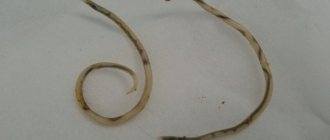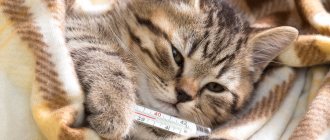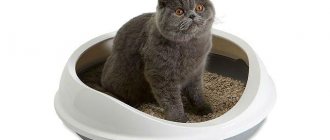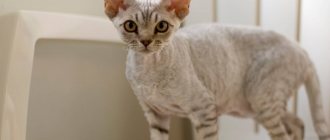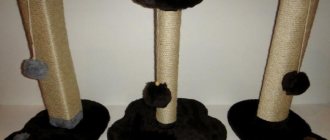Save the article:
It happens that a beloved pet receives a gift from nature of neighbors in the body - worms. Not the most pleasant neighborhood, from which the animal’s body will suffer for a long time if the owner does not undertake deworming. Worms in a cat are a serious disease that depresses all systems of the body: the animal loses weight, eats poorly, and becomes very tired.
Where does such a misfortune come from? Such unkind guests easily enter the body, but leave with reluctance. If you suspect unwanted neighbors, it is better to visit the veterinarian and find out who decided to destroy the cat from the inside.
Causes of worms in cats and kittens
The main reason for the appearance of worms in mustachioed pets is the ingestion of parasite eggs into the cat’s body. This can happen in the following ways:
- eating fish and meat products without prior heat treatment;
- communication with other representatives of the cat family (as well as dogs) – carriers of worms;
- through insects - fleas, flies, mosquitoes;
- through rodents (helminth eggs may be on their skins);
- quenching thirst from a dirty pond;
- through the owner's shoes;
- “picking up” eggs from grass, ground and other surfaces.
Note: kittens can become infected with helminths from their mother through milk or even in utero, so it is important to promptly deworm cats before pregnancy.
Scheme of infecting a cat with the most common worms - roundworms of the genus Ascaris
Nematodes
Roundworms most often parasitize the small intestine, esophagus, and infect the liver. Nematodes are able to penetrate the kitten’s body even when it is in the womb. Therefore, roundworms are most often found in kittens up to 2 months old, while they are feeding on their mother’s milk.
Nematodes are the causative agents of helminth infections such as hookworm disease and toxascariasis.
Hookworm
Hookworm is a round white parasite with a slightly reddish tint, up to 2 cm long, which inhabits the small intestine. The worm bites through the mucous membrane to feed on blood. As a result of its activity, many bleeding wounds appear, which leads to blood loss in the cat. Helminths live in the host’s body, and their larvae exist for a long time in water and soil and move long distances during rain. One female lays up to 16 thousand eggs daily.
Infection occurs in 2 ways:
- Through the mouth, when the cat licks itself, it eats food contaminated with larvae. An outdoor cat becomes infected through the rodents it hunts. Mice are carriers of this type of parasite. In the body of a rodent, hookworms can exist for up to 10 months and remain viable. Entering the cat’s intestines through the mouth, the larva after 2-3 weeks turns into an adult capable of reproduction.
- The larvae burrow through the skin and then migrate through the blood vessels. Hookworms enter the trachea, which causes the pet to cough. When coughing, the larvae enter the mouth, then the animal swallows them, and they end up in the stomach and intestines. After about 3 weeks, a sexually mature worm is formed from the larva.
Why are worms dangerous for cats?
Developing in the cat’s body, worms cause enormous harm to the animal’s body. Firstly, they injure the mucous membrane of the digestive tract mechanically - they gnaw and pierce the intestinal walls with their spines and teeth. Penetrating into organs, they disrupt the structure of tissues and cells, limiting their functional activity. Sometimes the worms multiply to such an extent that they block the lumen of the small intestine, causing its obstruction.
The damaged tissues of the organs in which the parasites live gradually decompose. The released toxic compounds are carried by the bloodstream, leading to poisoning of the entire animal’s body. In addition, the worms themselves release toxins during their life processes and during decomposition after death within the body.
If a cat has worms, its immune system is severely affected. A weakened pet is unable to fight other infections, which is the cause of the development of various bacterial, viral and fungal diseases.
In the case of abundant reproduction of worms, the animal’s psyche also undergoes significant changes. Constant itching, pain and other sensations lead to the fact that the cat becomes nervous and irritable, its sleep is disturbed and its appetite disappears.
Cestodes (white flat worms)
Cestodes or flatworms are a large group of parasites that are found in different animals. In cats, the most common are Dipylidia, Alveococcus, Diphyllobothria and Echinococcus. In feces, two types of worms can most often be found, which cause Diphyllobothriasis and Dipilidiosis.
They look like small (5-10 mm) white oblong inclusions that move along the surface of the feces. People mistakenly believe that these are adult worms, and if they have left the intestines, then nothing needs to be done to the cat. This is the main mistake.
The appearance of white worms in a cat’s feces means that a parasite up to 70 cm long has settled in the animal’s intestines. It has reached puberty, actively reproduces and secretes lower segments with fertilized eggs (in parasitology they are called “segments”). Moreover, he does not need a second individual, these worms are bisexual. Hermaphroditism (the simultaneous presence of male and female reproductive organs) is a distinctive feature of cestodes.
You can find white flat worms in a cat not only in the feces, but also around the anus, stuck to the fur, or when segments accidentally fall out of the animal’s anus.
Important! Worms that are in the cat’s body secrete special proteins that reduce the activity of the enzyme (trypsin) in the cat’s digestive juices. This way the helminths are protected from digestion and can live from several months to 1 year.
Types of white worms (Dipylidium, Echinococcus, Alveococcus, Diphyllobothrium) in cats
- Dipylidium, or cucumber tapeworm, enters the cat's intestines when an infected flea is accidentally ingested. When an insect is digested, a worm larva emerges, which attaches to the wall of the stomach and actively grows. She absorbs nutrients from food throughout her body. After the helminth reaches maturity, the process of formation of cocoons with eggs begins, which are located in the lower parts of the worm’s body. Then the white filled segments bud off and come out with feces. Next, the eggs are eaten by flea larvae and the process is repeated.
The disease in cats caused by the cucumber tapeworm is called dipylidia. There is a danger to humans only if an infectious flea is swallowed (in adults this is practically impossible, but in small children with close contact the risk of contracting dipylidia is much higher).
- Diphyllobothrium is a parasitic worm that is acquired by cats when they eat raw fish. During the digestion process, a white worm larva emerges from the fish and attaches to the wall of the animal’s small intestine. She lives there for 3-4 weeks and grows up to 1.5 m. During the period of its life, the long helminth secretes cocoons of eggs, which are released with the cat’s feces. After a month, the parasite completely leaves the body during vomiting or defecation.
Diphyllobothrium is also dangerous to humans and other carnivores. Their worm grows up to 10 meters with a lifespan of up to several years.
- Alveococcus is a small parasite, infection occurs by eating infected rodents. The worm larva penetrates the small intestine of the cat and grows for 3 months, reaching up to 5 mm in length, then forms segments with eggs, which break off as they mature and come out with the animal’s feces. In the environment, alveococcal eggs are preserved due to the formation of fine bubble foam, which attracts rodents. If a person accidentally eats grass with invasive foam, then tumor-like infiltrates (a vesicle with the head of a worm) are formed in the liver with the possibility of metastasis to the brain, lungs, and other organs. Infection leads to various disorders in the body, including death.
- Echinococcus is a small white worm, the size of which in the mature state does not exceed . A cat can become infected in two ways: by eating an invasive rodent (with an egg hatching into a worm larva inside) or by ingesting worm eggs from the grass. Depending on this, there are two options for the development of the disease. In the case of eating a rodent, the mechanism will be similar to alveococcosis. If a cat swallows Echinococcus eggs from the grass, then bubbles with worm heads will form in the internal organs of the animal, which will remain underdeveloped, but will bring a lot of painful sensations to the pet. In humans, infection proceeds similarly.
Appearance of worms in cat feces
All feline cestodes are united by external similarity in body structure. These are long, segmented white helminths with suckers that differ only in size.
What do segments of white flatworms look like in a cat’s feces:
| Parasite name | Adult worm size | Size of penis with balls | Appearance of a penis with eggs | Visualization of worms in feces |
| Dipylidium | 30-70 cm | 1-1.5 cm | Oval (like a grain of rice) | Naked eye |
| Diphyllobothrium | 100-150 cm | 1-1.5 cm | Short, rectangular | Naked eye |
| Alveococcus sexually mature | 0.5 cm | less than 1 mm | Oval | Under a microscope |
| Echinococcus sexually mature | 0.5-0.7 cm | less than 1 mm | Oval | Under a microscope |
A distinctive feature of feline cestodes is the short time period of motor activity of individual segments that were found in the feces.
Usually, after a few minutes, the energy reserve of the white segment runs out and it stops moving. However, the parasite eggs inside remain viable for a long time.
Symptoms of the disease
External clinical manifestations of cestodiasis in the early stages are usually absent. As the worms grow and develop, they release toxic substances that are absorbed into the cat’s blood and lead to increasing intoxication of the body.
Vomiting appears, uneven stools with an admixture of white worms in the feces, taste perversions, the feeling of hunger increases, and the body is depleted. Sometimes toxins affect the cat's nervous system, leading to seizures.
Treatment and prevention
To successfully cure worms, it is necessary to deworm the cat with veterinary drugs based on praziquantel. This active substance is included in the preparations:
- "Milprazon" (meat tablets for kittens and cats);
- "Milbemax" (chewable tablets for large and small cats);
- "Kanikvantel" (1 tablet with meat flavor, designed for 10 kg);
- “Cestal cat” (liver-flavored tablet – 4 kg);
- "Drontal cat" (4 kg tablet);
- “Profender” (drops on the withers);
- “Dironet (tablets, suspension and drops on the withers);
- "Prasitel" (tablets);
- "Fenpraz" (tablets with royal jelly).
For intestinal cestodias, a double dose of the drug with an interval of 10-14 days is usually sufficient. For greater effectiveness, medications are given in the morning, before feeding the cat.
After the animal recovers, the course of anthelmintic therapy will need to be repeated every 3 months to prevent re-infestation.
Important! If an animal has been diagnosed with cystic echinococcosis (bubbles in the internal organs), then the doctor prescribes complex treatment with special medications. The possibility of surgical intervention cannot be ruled out, since the cysts are constantly growing, putting pressure on surrounding tissues and impairing blood circulation. In addition, the bubble with parasites may burst, the fluid will spread in the cat’s body, which will further aggravate its condition.
Symptoms of worms in cats
By what signs can one suspect the presence of worms in cats? First of all, the owner should pay attention to the following symptoms:
A cat's bloated belly may be a sign of worm infection.
- change in eating behavior - the cat begins to eat more than usual without gaining weight, or, on the contrary, even refuses its favorite food;
- disturbances in the functioning of the digestive tract - difficult bowel movements alternate with diarrhea, pieces of undigested food are present in the stool, which indicates a malfunction in the enzyme system;
- anemia, weakness;
- the animal often licks the anal area due to itching;
- the hairline becomes dull, the fur falls out and becomes disheveled;
- mucous membranes acquire a yellow tint due to damage to the liver and gallbladder;
- the abdomen noticeably increases in volume;
- sometimes a cough occurs (a sign of worms entering the respiratory tract);
- Blood and mucus may be present in the stool.
Attention: the owner must remember that similar symptoms can occur with other diseases. If you give your cat an anthelmintic without laboratory confirmation of helminthiasis, this may lead to a worsening of its condition.
The effect of helminths on the animal
Worms are harmful to a cat's health. They deprive their prey of nutrients and vitamins. This leads to decreased immunity and anemia. The animal gradually weakens and becomes vulnerable to various infectious diseases.
Mechanical
Worms damage internal organs and tissues with their suckers. This often leads to the development of an inflammatory process and even necrosis. When there is a large accumulation of worms in the intestine, the walls become stretched and the lumen becomes blocked. Some animals die due to ruptures of internal organs.
Biochemical
Toxic substances that worms secrete poison the body. First, intoxication leads to allergic reactions. If no measures are taken, the cat will develop chronic dermatitis. Due to the constant presence of toxins in the body, the functioning of the liver and kidneys will be impaired.
Diagnosis of helminthic infestations
It is not difficult to guess that a domestic cat has worms if they (or their particles) come out along with feces or vomit.
Otherwise, if the above symptoms appear, and also periodically as a preventive measure, you should contact a veterinary clinic for diagnosis. It is better if the owner brings the animal directly to the veterinarian, because feces alone are in most cases not enough to detect parasites. This may be due both to the localization of helminths and to their insufficient maturity, when the worms are not yet able to lay eggs. Your pet's blood will be taken for laboratory testing and, if necessary, a sputum test will be prescribed. In some cases, the doctor may refer the cat for an X-ray examination of the lungs or an ultrasound examination of the liver and heart. In the process of identifying helminthiasis, they are differentiated from diseases of internal organs, poisoning, and colds.
ELUROSTRONGYLESISIS
Aelurostrongylus abstrusus is a pulmonary nematode 5-6 cm long (males) and 9-10 cm (females). The larva has a curved end part with sawtooth outgrowths.
Routes of infection
- Eating intermediate (land mollusks) or paratenitic (amphibians, reptiles, birds, rodents) hosts.
Life cycle
An infected animal releases larvae with feces into the external environment. Lung nematodes are biohelminths and develop only in living organisms. The first stage larva enters land mollusks (slugs, snails) and develops to the third stage. Paratenic (reservoir, transport) hosts eat snails. The larva can survive in them for up to 12 weeks. A cat becomes infected by eating intermediate or transport hosts. The parasite larva migrates from the intestine through the blood or lymph to the lungs, where it develops into an adult in the bronchioles and alveoli. Females lay eggs in the lungs, from which larvae hatch. The cat begins to cough and swallows the larvae into the digestive tract, from where they enter the external environment with feces.
The definitive host for Aelurostrongylus abstrusus is feline.
The intermediate host for Aelurostrongylus abstrusus is slugs and snails.
Paratenic host for Aelurostrongylus abstrusus – amphibians, reptiles, birds, rodents
Symptoms
Clinical signs depend on the degree of invasion. The disease can be asymptomatic or with vague symptoms. As a rule, the animal develops a weak or intense chronic cough, sneezing, and wheezing. Possible mucopurulent discharge from the nose, shortness of breath, rapid breathing. With massive invasion, even death. Chronic granulomatous pneumonia and bronchiolitis are observed in the lungs. The general condition of the animal is depressed, appetite and weight decrease, and the condition of the coat deteriorates.
Treatment of worms in cats
Treatment of worms in representatives of the cat family is carried out comprehensively and consists of solving several problems:
- destroy parasites;
- ensure their rapid removal from the animal;
- detoxify the body;
- restore immunity and functional activity of damaged organs.
For this purpose, anthelmintic drugs are used, which can be intended for both internal and external use. The products are available in different forms: deworming tablets, suspension, injections, drops.
Antihelminthics for cats for oral administration
Lungworm cycle
Medicines for deworming in cats intended for internal use have different effects on parasites. Some destroy the integumentary tissues and shells of eggs, others negatively affect the nervous structures, leading to paralysis of the helminth, and others disrupt metabolism. In addition, some drugs act only on adults, while others destroy larvae and eggs.
In accordance with the components included in the medications for worms, they are divided into broad-spectrum drugs and those aimed at exterminating only one type of helminth. The latter can be used only after an accurately established diagnosis.
Among the most common complex preparations for worms in cats are:
- Milbemax;
- Prasintel;
- Drontal;
- Prazicide;
- Fenasal.
When ridding your pet of worms, you need to carefully monitor its condition. Mass death of parasites can lead to severe intoxication of the cat, especially if there are significant numbers of them. An animal weakened by helminths may experience vomiting and diarrhea. You can help your pet with absorbent agents: you need to give activated carbon, enterosgel or others.
Deworming products for external use
External medications for helminths in cats are presented in the form of drops that are applied to the withers. These are: Bars, Profender, Drontsid and others. Such funds have both pros and cons. The first is ease of use, the main thing is that the animal cannot lick the place where the drops are applied. In addition, such a medicine destroys not only internal, but also external parasites - fleas and ticks, and also serves as a preventive measure for their appearance.
Among the disadvantages, the effect of the medicine is not strong enough, especially with a significant number of helminths. Drops are absolutely useless to use for helminthiasis caused by trematodes; the greatest effect is achieved if the disease in a cat is provoked by nematodes.
Injections for worms
In difficult cases, the veterinarian will prescribe anti-worm injections for the cat - Ivomec or Ivermec. The procedures will need to be carried out in a clinical setting, since preparing the solution yourself can lead to errors in dosage and the death of the animal.
Attention: the injection form of the medicine is not a prophylactic agent.
Anthelmintics
There are many modern effective anthelmintic drugs. They differ in their spectrum of action: some drugs kill only one type of parasite, while most act in a complex manner.
Based on the form of use, anti-worm medications are divided into several groups, and here you will have to experimentally find out which option is best for your pet.
Most often you can buy tablets in pet stores, such as:
- Drontal, cestal - acts on round and tapeworms, one tablet is given per 4 kg of animal weight;
- Milbemax/Milprazone is a complex-action drug that is destructive to both adult worms and their larvae; effective not only against worms that have settled in the intestines, but also in blood vessels and the heart;
- Dirofen - has a pronounced complex effect, but is especially effective against nematodes and tapeworms; It is also available in the form of a suspension and paste.
When giving medicine, under no circumstances should you frighten the animal, squeeze it, or hold it forcibly. Gentle stroking of the withers and neck will calm the pet, and then you can gently open its mouth and quickly place a pre-prepared tablet on the root of the tongue. After this, you need to close your mouth and, trying to hold her head up, lightly stroke her neck, encouraging her to make a swallowing movement.
If your pet stubbornly spits out the tablet, you can crush the drug and either mix it with your favorite cat treat, or dilute it with water and carefully inject it into the mouth from a syringe (without a needle!).
Suspensions
Suspensions are more convenient for use. Included with the medicine is an atraumatic syringe, with which it is not only easy to measure the required amount of the medicine, but also to quickly give the medicine to the cat. The main thing is to also try to get it on the root of the tongue so that the pet swallows the suspension.
The most common suspensions are Prasitel, Prazicide and Dirofen. Prazitel has a complex effect, killing parasites at any stage of development. Another advantage of this suspension is the absence of any taste.
Drops on the withers
Another type of anthelmintic drugs is drops on the withers: Stroghold. The medicine according to the dosage is applied to the withers of the animal, after a few days the procedure is repeated.
Prevention of helminthiasis
To prevent the appearance of worms in cats, it is enough to adhere to the following preventive rules.
- Avoid contact of your pet with unfamiliar or infected animals.
- When returning from the street, put your shoes in a separate closed place, not allowing the cat to sniff them. Wipe the hallway floor several times a day using disinfectants.
- Regardless of whether the cat goes outside or not, treat it with external products against fleas and other parasites.
- Eliminate raw fish from your mustachioed friend’s diet.
- Wash the tray and food bowl thoroughly and regularly.
Which animals are at risk?
First of all, we should abandon the stereotype “there is no place for a domestic cat to become infected.” Helminth eggs are found almost everywhere - in the soil and on its surface, on grass, etc. Therefore, even if the cat has never gone outside, the worms can “come” to her along with the owner’s shoes or on the wheels of a baby stroller.
But the likelihood of infection with worms increases under the following circumstances:
- the cat’s diet includes raw meat or fish (these foods often become a source of infection);
- the cat “communicates” with other animals (including the dog you walk outside, which can bring microscopic fragments of soil contaminated with helminth eggs on its paws);
- the cat has fleas (even if these are “random” 1-2 fleas, these parasites are carriers of worm eggs);
- there are mice or other rodents in the house;
- you took into your home a kitten whose mother was not dewormed before pregnancy (infection with worms can occur in utero).
Which cat worms can be transmitted to humans?
Take preventive measures when interacting with a cat, especially if you suspect the presence of worms
Although cats can be hosts to many types of helminths, not all of them are able to take up residence in the human body. For example, flukes pose a threat to the health of the owner: liver, pulmonary and other types. These worms “settle” in the internal organs of a person (liver, lungs), leading to disruption of their functions, tissue decay, hemorrhages, and even death.
Tapeworms, such as alveococcus, cucumber tapeworm and others, can also lead to the death of the owner. Anemia, allergies, blindness, death are the consequences of a person being infected by a cat with roundworms and nematodes.
It is especially important to prevent infection of children in families with cats. It is necessary to explain to the child why you should not kiss an animal, that after contact with it you need to wash your hands with soap, that you should not pet stray kittens on the street, and so on.
Danger to humans
There are helminthiases that can be transmitted from pets to humans:
- alveococcosis;
- diphyllobothriasis;
- dipylidosis;
- dirofilariasis;
- toxascariasis.
The main route by which helminths are transmitted to humans is through food and through contaminated hands. The above diseases lead to severe illness and even death. Therefore, deworming of domestic animals is also a primary measure to prevent human infection.
How to give your cat deworming medicine
Many owners are faced with the problem of how to give a pill to a cat. Pets resist in every possible way the owners’ attempts to open their mouths and push an incomprehensible bitter thing into it. To prevent physical and mental injury on both sides, you can use a number of proven techniques:
- crush the tablet into powder and pour it into your mouth;
- dissolve the tablet in a small volume of water, draw it into a syringe and pour it into the cat’s mouth;
- use the tablet dispenser.
Side effects of deworming
Improperly performed deworming can harm the kitten.
Unsuitable anthelmintics can cause side effects in your kitten:
- nausea, vomiting;
- foam at mouth;
- allergic reactions;
- dyspnea;
- problems with breathing and stool;
- sudden weight loss.
The most common adverse reaction is diarrhea. If it lasts no more than 38 hours, this is normal. This is how the pet’s body reacts to the active substances and accelerates the elimination of dead parasites. When side effects appear (nausea, vomiting, itching, muscle spasms, salivation), this indicates intolerance to the components of the composition. Then you need to change the anthelmintic.
In addition to side effects, improper deworming can lead to serious complications - anaphylactic shock, bleeding, sudden changes in pressure, breathing problems, and kidney function.
How to properly rid a cat of worms
In order for your pet to be treated for helminths with the greatest effectiveness, firstly, you should carefully study the instructions for the medicinal product. It is important to strictly follow the dosage recommended by the veterinarian or the annotation (in case of self-therapy). Before starting treatment for helminthic infestation, the animal must be treated for external parasites.
Some cats manage to hold the pill in their mouth and then spit it out, so the owner must not only place the medicine in the pet's mouth, but also make sure that it is swallowed.
In most cases, deworming medication is given to the cat twice, with an interval of two weeks. This is due to the life cycle of parasites. If the disease is advanced, the doctor may prescribe longer therapy.
After deworming, you must make sure that the activities were successful. This will require repeated control tests.
Treatment at home
Cestodes respond “well” to treatment with praziquantel, epsiprantel or fenbendazole. The first two remedies should be considered preferable, since they work especially well against Dipylidium caninum (it is considered the most common type of parasitic cestodes in pets).
- In addition, they are good at destroying all varieties of Taenia and Echinococcus. And this is despite the fact that only praziquantel is officially recognized as a means suitable for the destruction of echinococci.
- Fenbendazole is not effective against cucumber tapeworm, but can still be used against Echinococcus species. It is also used to destroy cestodes from the genus pseudophyllidean, but the dose has to be doubled compared to the standard recommended and the medicine must be given twice.
When not to deworm
There are several situations when you need to wait a little while treating cats for worms:
- serious condition of the pet;
- exacerbation of infectious diseases;
- cat pregnancy;
- lactation period;
- newborn kittens (usually age restrictions are indicated in the annotation for the drug).
It may also be difficult to deworm an aging cat. At this age, an animal should be treated for worms only in consultation with a specialist.
Flea remedies
Before deworming, you need to get rid of fleas, which are an intermediate host for worms. Currently, veterinary pharmacies provide a wide range of products to help cope with this problem.
Most used:
- Drops on the withers. Distributed throughout the fur. For example, Advantage.
- Sprays. For example, Frontline.
- Shampoos are most often used to get rid of fleas in small kittens. For example, Rolf Club.
- Collars are more suitable for prevention. Hartz et al.
- Powders are approved for use in pregnant cats.
The most effective way to get rid of fleas is a combination of several types of products. For example, wash the animal with shampoo and treat the fur with spray.
Owner stories
Sofia: “We adopted a cat from a shelter. It turned out that the cat had worms. Moreover, there were a lot of them, all the feces were strewn with larvae and parts of parasites, such small white things. We suffered with her until the veterinarian advised us this treatment regimen: Kanikquantel suspension three times with an interval of 2 weeks. We're doing well now."
Tamara: “My son brought a kitten from the street. I immediately realized that the cat had worms - the baby’s tummy looked like an inflated balloon. Poor thing, he suffered while he was a wanderer. The veterinarian said to give Prasitab tablets. One tablet is designed for an animal weighing 4 kg. I gave a little less than half, crushed it into powder and diluted it with water. This mixture was poured into the baby using a syringe without a needle.”
How to detect parasites?
As soon as a pet owner suspects that his pet has worms, he should immediately take him to a veterinarian.
To confirm or refute the diagnosis, you will need to undergo diagnostics.
The specialist conducts a test, checking the cat's feces for the presence of worms. It is worth saying that you may not be able to carry out the analysis once and calm down. If the parasites entered very recently, the result will be negative. Therefore, you will need to undergo such diagnostics several more times . If the diagnosis is confirmed, the doctor will prescribe treatment. Therapy should be started immediately and can be treated at home.
Symptoms of parasite infestation
Infection with each group of parasites has its own special symptoms. For ectoparasites this is:
- the appearance of small red spots on the cat’s skin (reaction to flea bites);
- formation of scratches - the cat constantly itches and tries to gnaw insects out of its fur;
- skin diseases (dermatitis) develop;
- the occurrence of baldness;
- the development of anemia (anemia) - occurs especially quickly in kittens, this can be understood by looking at the oral mucosa (it turns pale);
- change in behavior - the cat becomes irritable and aggressive;
- decreased appetite;
- deterioration in wool quality;
- in the presence of ear mites, the appearance of greenish tubercles and severe dirt in the cat’s ear.
You have to look for ixodid ticks on a cat's skin manually, carefully examining and feeling it.
External parasites can lead to dire consequences
Symptoms of internal parasite infestation:
- general cat malaise;
- dulling of fur;
- alternating constipation and bloody diarrhea;
- accumulation of dry crusts in the eyes of the animal;
- loss of appetite;
- weight loss or exhaustion;
- vomit;
- anemia;
- increased body temperature;
- the appearance of convulsions caused by intoxication from the decaying bodies of dead worms and their waste products;
- developmental delay in kittens;
- bloating and tightness of the abdomen;
- development of wheezing and coughing, asthmatic attacks in the presence of pulmonary and heartworms;
- the appearance of worm bodies in feces.
If any of these signs are present, contact your veterinarian immediately.
Often, when infected with parasites, apathy and malaise are observed.

